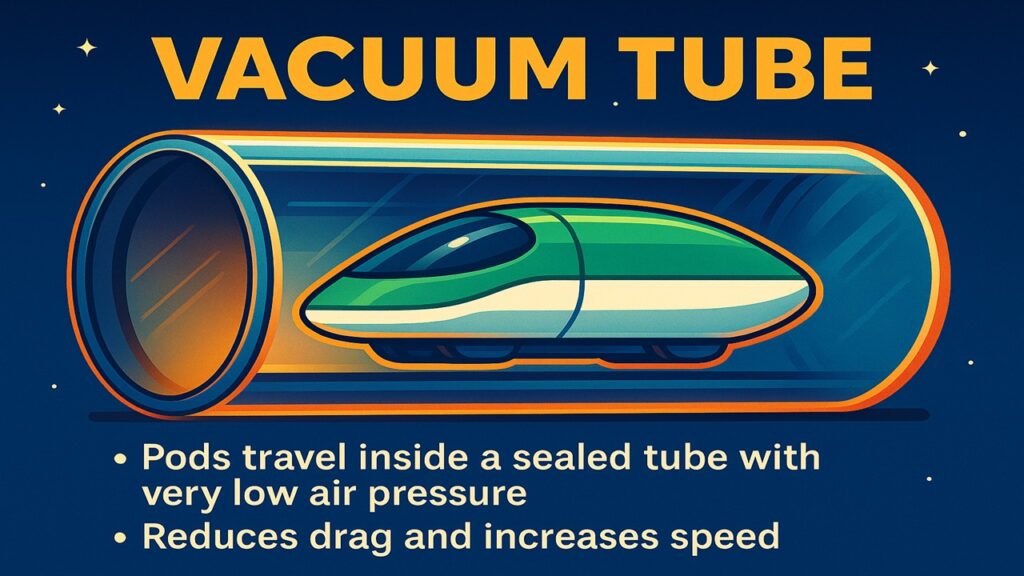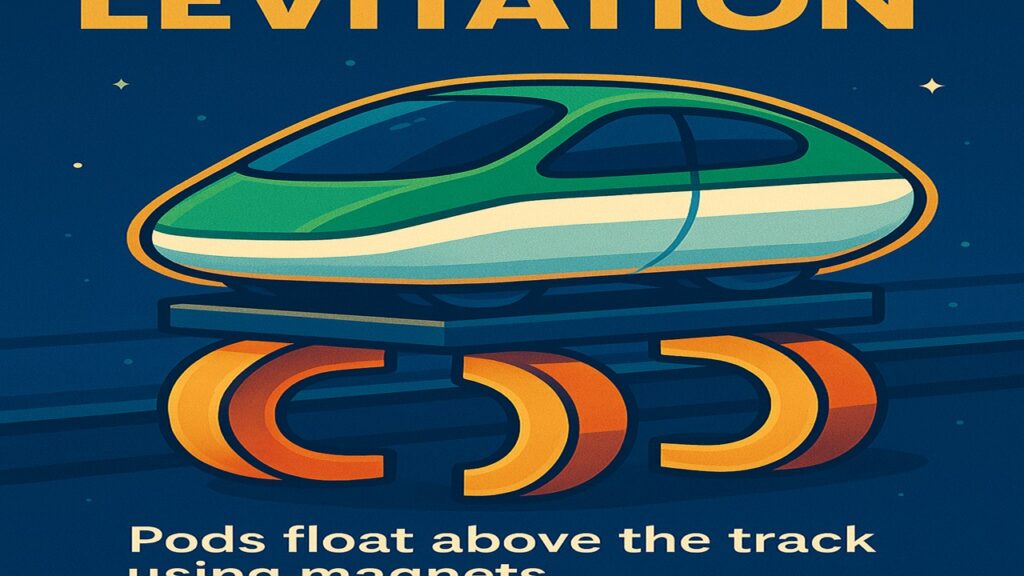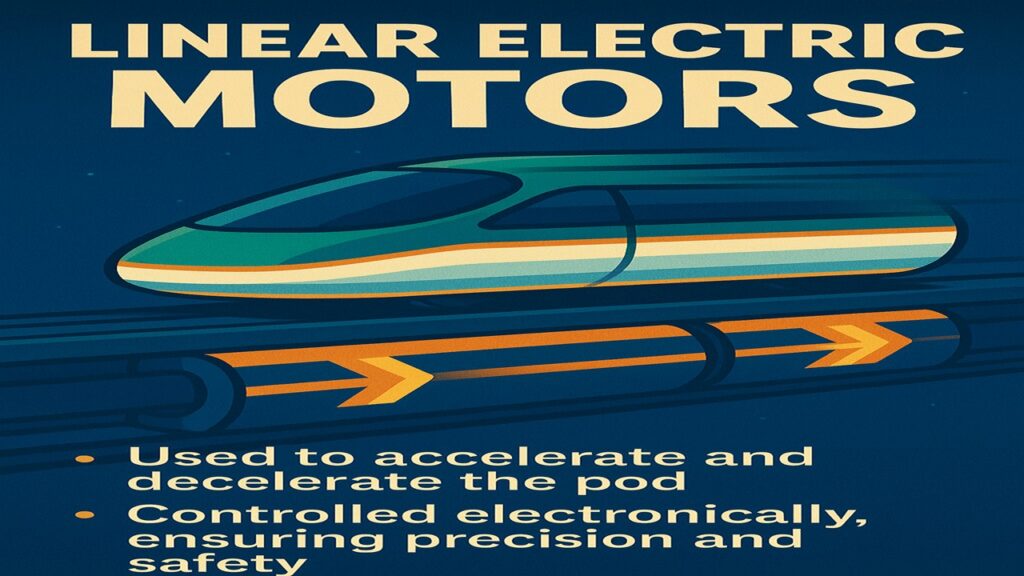
हिंदी में पढ़ने के लिए मेनू बार से हिंदी भाषा चयन करें।
When Travel Feels Like Rocket Speed
Imagine covering the distance between Delhi and Mumbai in just 90 minutes. No traffic, no airport rush, and no fuel-based pollution – just smooth, ultra-fast, futuristic travel. Sounds like science fiction? It’s not. This is the promise of Hyperloop – a revolutionary transportation concept that could change the way we travel forever.
While airplanes run at 800–900 km/h, Hyperloop is being designed to exceed 1000 km/h, combining speed, sustainability, and safety. Big tech companies and governments are working to bring this futuristic idea to life.
What is Hyperloop?
Hyperloop is an ultra-high-speed transportation system where passengers or cargo are transported in a low-pressure tube through magnetically levitated pods.
Instead of rolling wheels and air drag, Hyperloop uses:
- Magnetic levitation (Maglev) to float the pod
- A vacuum tube to reduce air resistance
- Electric propulsion for acceleration
Speed: 1000–1200 km/h
System: Sealed tubes with minimal air pressure
Goal: Fast, safe, green, and cost-effective transport
Who is Developing Hyperloop?
Many companies and countries are investing in this transformative technology:
🔸 1. Virgin Hyperloop (USA)
Inspired by Elon Musk’s Vision
Virgin Hyperloop was one of the first companies to actively pursue the Hyperloop concept proposed by Elon Musk. Backed by billionaire Richard Branson, the company adopted Musk’s open-source idea and worked on turning it into a reality.
Conducted the First Successful Human Trial in 2020
In November 2020, Virgin Hyperloop made history by completing the world’s first passenger test ride at its test track in Nevada. Two passengers traveled in the XP-2 pod at a speed of around 172 km/h. Though far below the target 1000+ km/h, it was a major milestone in validating the safety of the technology.
Virgin Hyperloop has since focused on cargo and freight-based applications and is exploring international routes, including in India and Saudi Arabia.
🔸 2. Tesla & The Boring Company (USA)
Elon Musk Originally Proposed the Hyperloop Idea in 2013
The concept of Hyperloop was first formally introduced by Elon Musk in a 2013 white paper titled Hyperloop Alpha. He described a system where a pod would travel through a low-pressure tube at near-supersonic speeds.
Published an Open-Source Concept Called “Hyperloop Alpha”
Instead of developing the technology through Tesla directly, Musk made the idea open-source, encouraging companies around the world to innovate on the concept. Meanwhile, his company The Boring Company began developing underground tunnels (e.g., in Las Vegas) as part of a broader transportation solution, sometimes linked with Hyperloop-like systems.
While Tesla is not actively building a Hyperloop for public use, Elon Musk’s companies have continued to experiment with vacuum tube transport and remain key influencers in the space.
🔸 3. Zeleros Hyperloop (Spain)
Focused on Scalable and Safer Systems
Zeleros is a European Hyperloop company headquartered in Valencia, Spain. It emphasizes a design that minimizes infrastructure complexity. Unlike other systems that rely on vacuum pumps throughout the tube, Zeleros incorporates on-board propulsion and levitation systems within the pod itself, making it easier to scale across long distances.
Supported by European Partners
The company has received support from the European Commission, as well as major transport companies, airports, and research institutions. Their system aims to reduce infrastructure cost, improve energy efficiency, and comply with global transport regulations.
Zeleros is currently working on building a European Hyperloop Development Centre and testing full-scale prototypes.
🔸 4. Hardt Hyperloop (Netherlands)
Working on Intercity Hyperloop in Europe
Hardt Hyperloop, based in the Netherlands, is collaborating with governments and institutions across Europe to develop an interconnected Hyperloop network between major cities. Their focus is on seamless transportation with high levels of safety, comfort, and automation.
Backed by the EU and Private Investors
Hardt has attracted funding and technical support from the European Union, the Dutch government, and companies like Tata Steel and Schiphol Airport. It has already built a test facility in Delft and is conducting system-level trials.
Their long-term goal is to create a pan-European Hyperloop grid that can carry both passengers and cargo efficiently, cutting travel time significantly between cities like Amsterdam, Berlin, and Paris.
🔸 5. India: Mumbai–Pune Hyperloop Project
Proposed to Be the First Hyperloop Corridor in Asia
India is one of the few countries seriously exploring Hyperloop implementation. The Mumbai–Pune Hyperloop is a proposed route that aims to connect two of Maharashtra’s major cities—reducing the current 3.5-hour road journey to just 25–30 minutes.
Aims to Reduce a 3.5-Hour Journey to Just 30 Minutes
The project received early support from the Maharashtra government and was included in the infrastructure vision of NITI Aayog. Virgin Hyperloop had signed agreements for feasibility studies, and the route was declared a public infrastructure project, which would allow faster regulatory clearances.
Though currently on hold due to political and financial complexities, the Mumbai–Pune route remains a strong candidate for Asia’s first operational Hyperloop corridor.
How Does the Hyperloop Work?
Hyperloop is not just another train system — it’s a technological breakthrough combining advanced physics, magnetism, and energy efficiency to achieve incredible speeds. Here’s a breakdown of its core components and how they work together:
📦 Vacuum Tube

• Pods travel inside a sealed tube with very low air pressure
The main travel route of the Hyperloop is a long, sealed tube — almost like a giant pipeline. Inside this tube, the air pressure is significantly reduced, similar to conditions at 200,000 feet above sea level.
This creates a near-vacuum environment, making it easier for the pods to glide with minimal air resistance.
• Reduces drag and increases speed
In normal trains or planes, most of the energy is used to overcome air drag. But in a vacuum tube, drag is almost eliminated. This allows Hyperloop pods to reach extremely high speeds (1000+ km/h) using less energy and without turbulence.
🧲 Magnetic Levitation (Maglev)

• Pods float above the track using magnets
Hyperloop uses magnetic levitation — a technology where magnets are used to lift the pod slightly above the track, so it doesn’t physically touch the surface. This eliminates rolling friction caused by wheels.
Two types of magnets are used:
- Electromagnets to lift the pod (levitation)
- Stabilizing magnets to keep it balanced in the center of the tube
• Eliminates friction for smoother, faster travel
By removing contact with the track, the pod can move silently and smoothly at high speed. This also reduces maintenance costs and makes the system safer and longer-lasting.
⚙️ Linear Electric Motors

• Used to accelerate and decelerate the pod
Unlike traditional motors that rotate wheels, Hyperloop uses linear electric motors that create motion in a straight line. These motors are placed at intervals along the tube and generate a magnetic field that pushes or pulls the pod forward.
This allows the pod to:
- Accelerate gradually
- Decelerate smoothly
- Maintain high speed with precision
• Controlled electronically, ensuring precision and safety
All movements — acceleration, speed control, and braking — are handled electronically through software. This ensures that each journey is automated, optimized, and monitored in real time, making it much safer than traditional rail systems.
Together, these three core technologies — vacuum tubes, magnetic levitation, and linear motors — create a futuristic transportation system that promises speed, comfort, efficiency, and environmental sustainability.
💡 Benefits of Hyperloop Technology
Hyperloop isn’t just about speed — it offers a complete transformation in the way we travel, making transportation faster, safer, cheaper, and greener. Here’s how it benefits people and the planet:
⏱️ 1. Unbelievable Time Savings
• Delhi to Mumbai in 90 minutes
Currently, a flight between Delhi and Mumbai takes around 2 hours, plus additional time for check-in, security, and boarding. Hyperloop can reduce this entire journey to just 90 minutes door-to-door, revolutionizing intercity travel.
• Bengaluru to Chennai in 30–40 minutes
On busy routes like Bengaluru–Chennai, which takes over 6 hours by road and about 1 hour by flight, Hyperloop can cut travel time to under 40 minutes, making it perfect for daily business commutes or weekend trips.
⏩ Impact: People could live in one city and work in another without relocation. It brings metro cities closer like never before.
🛡️ 2. Safe and Controlled Travel
• Fully automated system
Hyperloop is designed to be completely autonomous, using AI and computer systems for navigation, speed control, and safety management. There’s no human driver — reducing the chances of human error.
• Minimal risk of accidents or delays
Since the pods move inside a sealed tube, there’s no chance of traffic, weather disturbances, or animal crossings. It’s protected from external hazards, making the journey extremely reliable and punctual.🛡️ Impact: Hyperloop could become one of the safest modes of transport, with zero surface traffic interaction and maximum precision.
💰 3. Cost-Effective Travel
• Cheaper than airplanes and high-speed rail
Despite its futuristic design, Hyperloop has the potential to be more affordable than air travel and even bullet trains. Lower energy use, automation, and reduced infrastructure wear lead to lower operational costs.
• Low operational costs and energy-efficient
With magnetic levitation and electric propulsion, energy use is optimized. Since there are no wheels or fossil fuels involved, maintenance costs are lower, and bulk travel becomes economically viable.
💸 Impact: Over time, Hyperloop could provide high-speed travel for the price of a regular train ticket, making fast transport accessible to the middle class.
🌱 4. Environment-Friendly
• Runs on renewable electricity (e.g., solar power)
Hyperloop systems are being designed to run on clean energy sources such as solar, wind, or grid-based electricity. This reduces dependence on petrol or diesel and makes the system future-proof.
• Zero carbon emissions – a green transportation mode
Unlike flights or diesel trains, Hyperloop produces no direct greenhouse gas emissions. It aligns with global efforts to combat climate change and reduce urban pollution.
🌍 Impact: In an era of climate crisis, Hyperloop could become a flagship example of sustainable transportation, reducing the carbon footprint of intercity travel.
🔮 Future Outlook: Will It Become Reality?
While Hyperloop has captured the imagination of engineers, governments, and investors alike, the question remains: Will it really become a part of our daily lives? Let’s explore the current progress, future potential, and key challenges.
🚧 1. Current Status: Still in the Development Phase
Most Hyperloop systems are currently in the prototype and testing stages. While successful small-scale trials (like Virgin Hyperloop’s passenger test in 2020) have shown that the technology works, a full commercial system is still under development.
Governments in India, UAE, USA, and Europe are collaborating with private companies to study feasibility, infrastructure needs, safety protocols, and economic viability.
🔬 Status Check: The technology is real, the engineering is promising, and early tests have been successful — but large-scale deployment is still a few years away.
📅 2. Timeline: Commercial Launch in 5–10 Years
Experts suggest that the first commercial Hyperloop routes could become operational between 2028 and 2035, depending on government approvals, funding, and construction challenges.
Some likely first-use cases include:
- Cargo and freight transport (simpler and less risky than passenger travel)
- Short intercity routes with high traffic (like Mumbai–Pune or Dubai–Abu Dhabi)
🕒 Outlook: If things go as planned, Hyperloop may soon start with cargo lines, followed by passenger services once the safety and efficiency are proven on a mass scale.
3. India’s Potential: A Global Hyperloop Leader
India, with its dense population and long-distance intercity travel needs, is an ideal candidate for Hyperloop implementation.
The proposed Mumbai–Pune corridor could serve as Asia’s first Hyperloop system, setting an example for other countries. India’s push for smart infrastructure and renewable energy also aligns perfectly with Hyperloop’s goals.
🌟 Opportunity: With the right political support and private investment, India could become one of the first countries to deploy a real-world Hyperloop system.
⚖️ 4. Challenges Ahead
Despite the potential, several obstacles still remain:
- Regulatory approvals for new transport systems
- High initial infrastructure costs
- Public safety concerns
- Land acquisition and construction delays
These are the same hurdles faced by many disruptive technologies, but with global collaboration and innovation, they are solvable over time.
⚠️ Reality Check: The road to revolution is not easy — but it’s moving forward step-by-step.
A Bold Leap Toward Tomorrow
Hyperloop is not just a fast train — it’s a symbol of progress, a glimpse into how science and engineering can reshape human mobility.
As development continues and global partnerships grow, Hyperloop is shifting from a bold idea to a soon-to-arrive reality.
“Every great leap in history began with a bold vision. Hyperloop is that leap for the future of travel — faster, cleaner, and smarter.”

































































